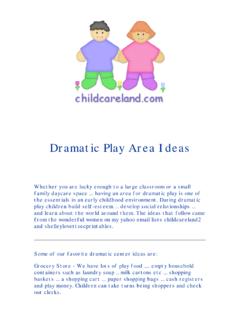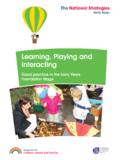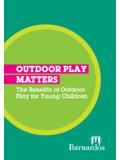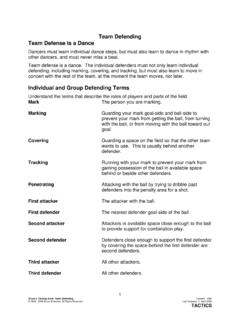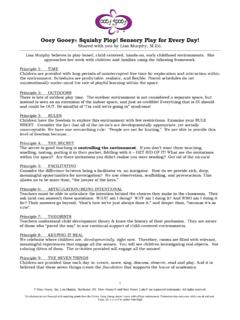Transcription of 25 Easy Nature Play Ideas for Preschools - greenheartsinc
1 GreenHeartsInstitute for Nature in Childhood 25 easy Nature play Ideas for Early Childhood Centers Great Nature play doesn t require elaborate and expensive play spaces! Even a limited outdoor area can be affordably enhanced for Nature play , using common materials and plants to create a young child s heaven that is chock-full of small-scale wonders and magical discoveries. Try the suggestions in this brochure, and then add your own Ideas over time! Why More Outdoor play ? For eons children have enjoyed the outdoors as their greatest playground climbing trees, digging holes, catching frogs, building forts, picking berries, or just running gleefully through tall grass. These are fond memories for most adults, but unfortunately they have little to do with modern childhood. Today s children are disconnected from Nature . American kids (ages 3 12) now spend 27 percent of their time with electronic media, versus only one percent outdoors.
2 If you count only time for unstructured outdoor play that is, play that kids make up themselves, on their own schedules it amounts to just 30 minutes per week! With a little planning, outdoor enrichment, and commitment, your early childhood program can easily double that weekly amount of outdoor free play ! This kind of play is perfect for developing the whole child. In fact, a growing body of research shows that frequent, unstructured play in diverse natural settings is great for: Social and emotional development; Creative development; Intellectual development; Physical fitness and overall health; and Creation of lasting personal bonds to the natural world. What Makes the Best Nature play ? Green Hearts promotes three key dimensions of great Nature play . 1. The right kind of place: A naturalistic area where kids are free to explore, play , and relax and even to cause a little minor damage.
3 The richer the space, the better: extensive and diverse plantings, dirt piles or digging pits, water, shrub dens, vines, boulders, secret niches, expanses of sand, balancing logs, etc. The space doesn t need to be large, but it should be dense with natural features, on the small scale of young children! 2. The right kind of play : Truly free play , where the kids make it up as they go. Adult supervision is fine and necessary for all child care, but adult intervention should be limited. Let the kids use their own imagination to create play ; don t try to be their coach! If the site is naturally rich, they ll find plenty to do. And be sure to stress play with Nature , digging, wading, picking, catching, smelling, climbing, etc. not just play in Nature ! 3. The right kind of re- play : That is, frequency! Research finds that the greatest impacts of Nature play come when it is a regular part of children s lives.
4 Early childhood centers have the perfect opportunity to provide that frequency, since kids return to your site day after day. Even a small play area can offer a powerful experience of Nature for your young children! For more Ideas and understanding, visit Be sure to check out our Parents Guide to Nature play . Also, please consider Green Hearts for a keynote address or workshop about Nature play at your next early childhood conference! Ideas You Can Do ! Outside Door Use it more than you already do, in all safe weather conditions! Water Kids love water play ! Provide water from multiple sources, if possible: a hose, a faucet, a sprinkler, a rotating sprayer, a rain barrel, a hand pump, or even just spray bottles. Water Transport Part of the fun of water play is moving it around! Use watering cans, buckets, hollow bamboo poles, plastic pipe (with curves & connectors), plastic gutter sections, pots and pans, recycled milk jugs, etc.
5 You can get the water from a faucet or hose, or use rain barrels to collect it. Digging Pit Just plain dirt, going down plus kid-sized shovels. If you have heavy clay soil, you may want to lighten it by mixing in a few bags of sand or mulch. Pea gravel or plain mulch can also be used for digging pits. Note: Dirt digging pits will miraculously turn into mud puddles after a rain. Your kids won t mind a bit but be sure to forewarn their parents! Dirt Pile Just plain dirt, going up. The larger the pile, the more fun and creative play your kids will have. It will inevitably get muddy and messy and your kids will have even more fun! Leaf Pile If you re lucky enough to have large deciduous trees nearby, rake the fallen leaves into giant piles and let the kids have at em! Better yet, let your kids do the raking they ll love it! The good memories will last longer than the leaves.
6 Sand Lots of it! contained by shrubs, landscape timbers, old tires used as planters, boardwalks, whatever. The more sand, the better! Avoid small commercial sand boxes, which don t have much magic to them. Have a source of water nearby, or a handy way for kids to take water to the sand since sand becomes really great for artistic play when it s wet! (Note: Check with your license inspectors about requirements for covering your sand area at night. Sometimes landscape-scale sand areas have less burdensome cover requirements than smaller sand boxes.) Plants ! Lots of Plants ! Everywhere ! Grow plants in beds, in giant pots, in window boxes, in old tires, and vining up trellises and trees. Choose plants for species diversity, various colors, different heights and textures, and strong fragrances. Have the kids help plant and care for them. Raised garden beds can help protect young or more fragile plants from active preschooler play .
7 And if you don t have a good shade tree, buy the largest one you can afford and have it planted by the pros. Use a hardy, native species; protect it from harsh play until it is established; and don t compact the soil over the root zone. It will take years to become a great play tree, but the sooner you get it Vegetable Garden Choose vegies that will ripen during your school season either rapidly in the spring (like peas, radishes) or ones that will be ready in late summer. (If you operate year-round, this is no issue.) Good possibilities include potatoes, sugar snap peas, corn, carrots, and cherry tomatoes. Use planting beds, giant pots, or both. If you have a sunny window sill, you can start most veggie seeds inside during late winter or early spring, and then transplant them outside after last frost. If garden care is needed during vacations, ask one family to voluntarily tend the garden each week until school re-opens.
8 Pumpkin Patch Pumpkins are unique enough to merit their own category! They are not hard to grow, but they benefit from lots of rich compost or plenty of fertilizer, and they won t mature until fall. Pumpkin vines need plenty of room to run, but you only need two or three plants. (No need to grow a separate pumpkin for each child!) Butterfly Garden Plant a jumbled selection of insect-attracting flowers, both annuals and perennials. Ask your local garden center for help in choosing good plants, or research this on the internet. Don t forget food plants for the caterpillar life stage, like ones from the parsley family. (Note: your local Extension Service is an excellent source for advice about plants. Their Master Gardeners may even help you establish your gardens, since they are committed to volunteer community service.)
9 Ask!) Milkweed and Monarchs Milkweed inevitably attracts Monarch butterfly caterpillars, as it is the only thing that they eat! The caterpillars ( easy to identify with a field guide or the internet) can be collected by cutting a branch they re on, and then placing them (with the branch) into a screened box (about the size of a ten-ream paper box). Keep the box supplied with fresh milkweed leaves until the caterpillars turn into chrysalises (usually in less than a week). There must be a bare twig or two leaning up in the box, from which the chrysalises can hang in open air. After 9 to 14 days an adult butterfly will break out of the now-transparent chrysalis. Be sure there is enough room in the box for its wings to fully open, so they won t be deformed and then release the adult within a few hours. This is a truly magical process for children to see! (Note: Swamp milkweed from a nursery is prettier than the Common milkweed that grows wild everywhere, and it works just as well.
10 Logs Just lay one or more large logs on the ground for balancing, sitting, and hiding. Stake them in place or partially bury them, so they can t roll unexpectedly. Lay several together in an end-to-end zig-zag to produce a nice challenge course! (But have a soft fall surface around them, just in case.) Tree care services are a good source for logs from trees they have had to cut. They might even be sweet-talked into free delivery! Tunnels You can make a simple tunnel by burying a culvert pipe under a mound of dirt; put a layer of sand inside for comfort. You can also create tunnels by growing gourds, beans, or other vines over a row of store-bought trellis arches. For a different sort of living tunnel, plant willow whips (cut, straight stems) in parallel lines, and tie the tops together as they grow. Most species of willows will grow well from stems that are cut during their dormant winter months, stuck firmly into soil (cut end down), and kept moist until they start growing.


